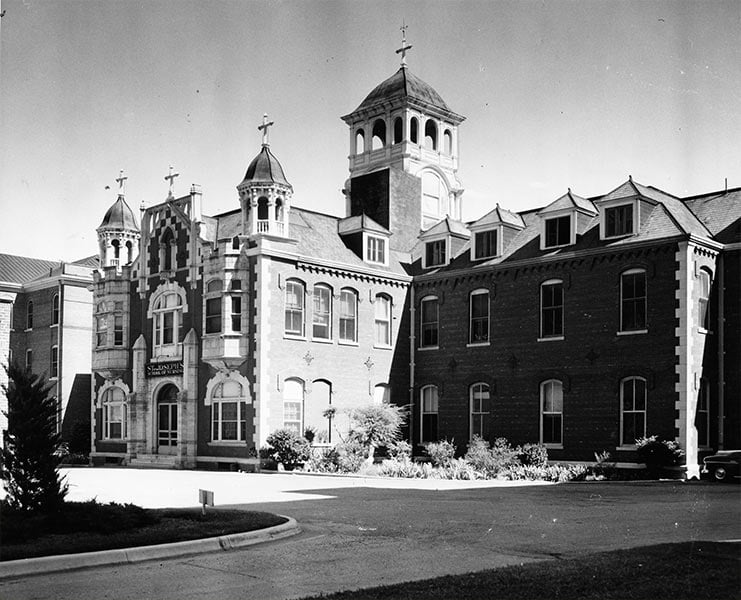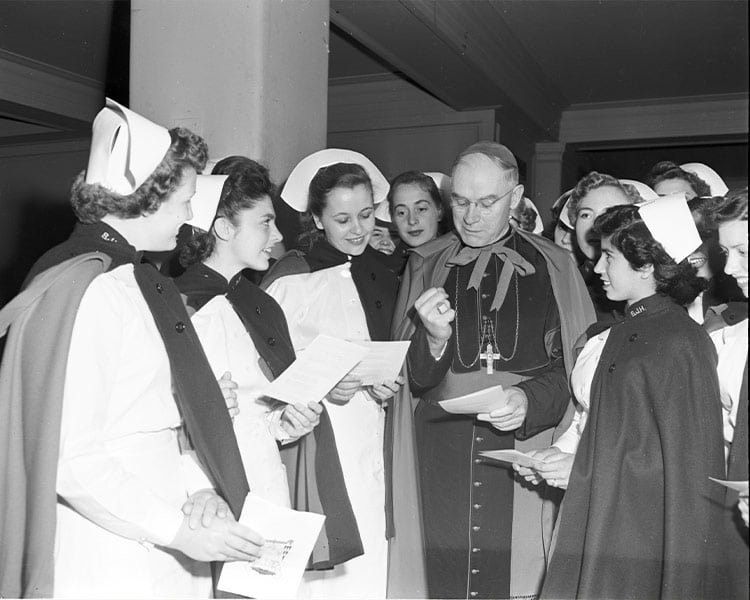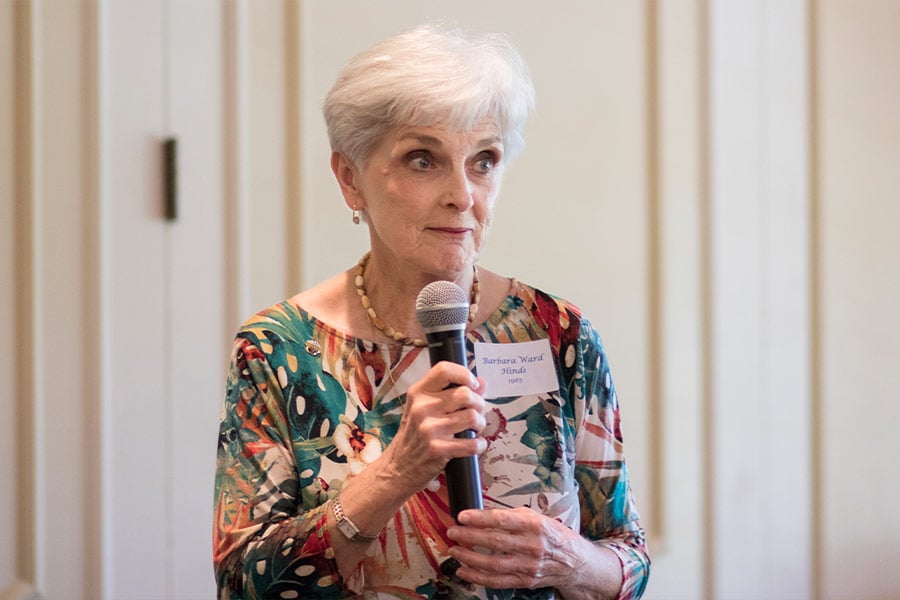Health care rooted in the Catholic Faith, Part 3: A Godsend for Cowtown

The arrival of the Sisters of Charity of the Incarnate Word in 1885 to take over nursing duties at the local railroad infirmary provided nothing short of a miracle for the people of Fort Worth.
Prior to the existence of the railroad infirmary, Fort Worth had no place to care for the sick. According to Richard Selcer in his book Hell’s Half Acre, the city jail was the only place some of the sick could find a bed around 1877, provided there were no outlaws behind bars. Referencing Fort Worth City Council minutes from that year, the author wrote that Fort Worth “opened the building during slow times to sick and diseased indigents because the city had no public hospital.”
The construction of the railroad infirmary was an improvement, certainly, but quality care was still lacking. That changed when the sisters arrived.
The religious order had built a reputation for excellence in nursing in Galveston and San Antonio, and the sisters were optimistic about the future in Fort Worth. In her diary, one of the sisters wrote that the infirmary grounds in Fort Worth were “ideally situated on an elevated plain and surrounded by extensive grounds, affording ample facilities for fresh air and light.”
Living in rudimentary quarters, the early sisters made the most of their environment, planting fruits and vegetables on land behind the infirmary, raising chickens for eggs, and maintaining a cow for milk. In addition to their hospital duties, they performed all the necessary upkeep and laundry services. Historical records state that 20-hour workdays were not uncommon for the sisters.
The same year the Sisters of Charity of the Incarnate Word came to Fort Worth to care for patients, a fire broke out at the infirmary. The sisters managed to transfer every one of the patients to safety. One of the sisters had been attending Mass at St. Stanislaus Kostka Catholic Church, later to be rebuilt and renamed St. Patrick Catholic Church, now the Cathedral. The sister rushed back when she heard news of the fire and, despite the flames, ran inside to be absolutely sure no one had been left behind. She died in the fire. There were no doubts among Fort Worth residents about the dedication of the Sisters of Charity of the Incarnate Word.
In short order, the sisters had taken possession of the infirmary, rebuilt it, and enamored themselves to the residents of Fort Worth. Completed in 1889, the rebuilt structure was known as St. Joseph Infirmary.

Saint Joseph Hospital School of Nursing was established and built by the Sisters of Charity of the Incarnate Word in 1906. (Fort Worth Star-Telegram Collection, UTA Libraries)
Growing strong in spirit
Mother St. Pierre knew that the virtuous character of a city was defined by how its residents care for one another and her religious order’s medical facility served as the perfect example in Fort Worth.
“A community does not get strong by members,” Mother St. Pierre said, “but by the true spirit of self-sacrifice and devotion for others.”
By the early 1890s, the infirmary included an operating room, a ward accommodating 100 patients, private rooms, and even a pharmacy.
In 1897, St. Joseph Infirmary even had an emergency transport system in place. The local newspaper at the time reported that three physicians donated “a fine pair of Hambletonian bay horses for their ambulance service.” The reference to the type of horses strongly suggests they descended from the bloodline of Hambletonian, one of the fastest thoroughbred racehorses of the late 18th century.
Remarkably, in addition to this unprecedented progress, the sisters managed to build a three-story brick hospital by 1898. Operating rooms were expanded and a chapel was added.
Sisters usher in enormous developments
By 1906, a larger, three-story addition more than doubled the size of St. Joseph. The expanded infirmary now included three operating rooms, a delivery room, an emergency room, and 165 beds. Even then, it was widely considered to be one of the best-equipped and most modern medical facilities of its kind.
The sisters were moving at warp speed, earning a charter by the state of Texas to open up
St. Joseph Training School for Nurses in 1906. A long line of well-trained nurses began graduating from the nursing school beginning in 1908.

Diocese of Dallas Coadjutor Bishop Thomas K. Gorman visits with young nurses from Saint Joseph Hospital School of Nursing in 1952 at St. Patrick Catholic Church, before it became a cathedral. (Fort Worth Star-Telegram Collection, UTA Libraries)
During the local peak of the Spanish Influenza epidemic in 1918, the sisters cared for a multitude of patients, including many from Camp Bowie, just three miles to the west of downtown Fort Worth. Once again, planning by the Catholic Church for medical needs of a community proved to be a wise move, as a modern hospital was in place when it was desperately needed.
As Texas and the nation grew, the sisters always managed to not only keep pace, but also to stay several steps ahead of the times. In 1927, the sisters undertook a $500,000, five-story expansion of the infirmary. As early as 1930, the Catholic-run care facility — now named St. Joseph Hospital — was one of the most modern of its kind, with electric elevators and more than 200 beds for its patients. The modern facility also included areas where patients could experience God’s grandeur in the great outdoors.
A 1930 hospital description of the new construction stated, “There are sun porches on each floor so planned and equipped with wide entrances that the patient’s bed may be conveniently rolled out, thus pressing sunshine into health-giving service.”
A long line of organizations gave sanctioned accreditation to St. Joseph Hospital over the years, starting in 1920. They included the American College of Surgeons, American Medical Association, American Hospital Association, and Joint Commission on Accreditations of Hospitals.
Eventually St. Joseph Hospital grew into a complex of 10 buildings, covering 570,000 square feet on six acres. In 1993, St. Joseph medical workers included 625 doctors and 1,000 people on the general staff.
Building on a reputation for excellence
One of the St. Joseph staffers, John Burk, M.D., worked at the hospital for nearly two decades starting in the mid-1970s. He admired the high standards established by the Sisters of Charity of the Incarnate Word and said he enjoyed working with them.
“It was a very, very, very caring environment,” Dr. Burk recalled. “The nuns just shared their commitment to caring for folks with staff and that was the environment you lived in and worked in.”
Today, Dr. Burk is a pulmonary and critical care specialist caring for COVID-19 patients at several area hospitals.
Marlene Bass, a registered nurse who is now retired, also recalled the high-quality care offered at St. Joseph. She graduated from the St. Joseph Hospital School of Nursing in 1959. The sisters put Bass on the fast track to her nursing diploma, condensing a four-year program into three with year-round schooling and intensive hospital training. At only 20 years of age, Bass had passed her state examinations and became a registered nurse.
Soon after graduation, she was assisting during brain surgeries, plastic surgeries, and wherever she was needed at operating facilities at the busy St. Joseph Hospital. “It was a major hospital at the time, and I learned a lot, quickly,” the retired surgical nurse said.
The sisters demanded excellence, Bass recalled, “but you learned the correct ways to do a procedure and it stuck with you the rest of your life.”

Barbara Ward Hinds speaks during the St. Joseph Hospital School of Nursing Alumnae Association homecoming June 9 at Colonial Country Club. (NTC/Jayme Donahue)
Barbara Hinds, a 1965 graduate from the nursing school, agreed.
“The sisters had high standards, and they expected a lot from us,” Hinds said about her nursing school instructors. “We had a lot of hours working at the hospital, practical hours of training. When we came out, we hit the ground running.” The training prepared Hinds well for a 50-year career in health care.
Both Hinds and Bass also said that during their time at the nursing school and hospital, the Sisters of Charity of the Incarnate Word (CCVI) fostered an environment that was caring and centered on Christ.
“It was like everybody was a family,” Bass said, adding that her daughter worked at St. Joseph Hospital for 14 years. “When the hospital was closing, she said to me that it was like losing family.”
That closing time came for St. Joseph Hospital when it was showing signs of age at the end of the 20th century, during an era when hospitals were being run by municipal and secular organizations. In 1994, it was purchased by the Columbia/HCA Healthcare Corp., and by the next year it was closed. John Peter Smith Hospital bought the property in 2008 and demolished it in 2012.
Catholic sisters establish lasting legacy
In commemoration of the work of the CCVI sisters and the countless people involved with St. Joseph Hospital over the decades, JPS Health Network plans to erect a future monument. It will be built with some of the 20,000 bricks salvaged from the 2012 demolition.
Also, a new inpatient hospital is planned by JPS Health Network on the six acres where St. Joseph once stood.
Although a six-acre greenspace is all that remains of St. Joseph Hospital, a world-class medical district now surrounds it. The surrounding area which the sisters said was “ideally situated on an elevated plain and surrounded by extensive grounds, affording ample facilities for fresh air and light” now is home to some of the largest hospitals in North Texas, as well as numerous clinics, medical offices, and other care facilities.
The legacy of the Catholic Church and the Sisters of Charity of the Incarnate Word is alive and well.
